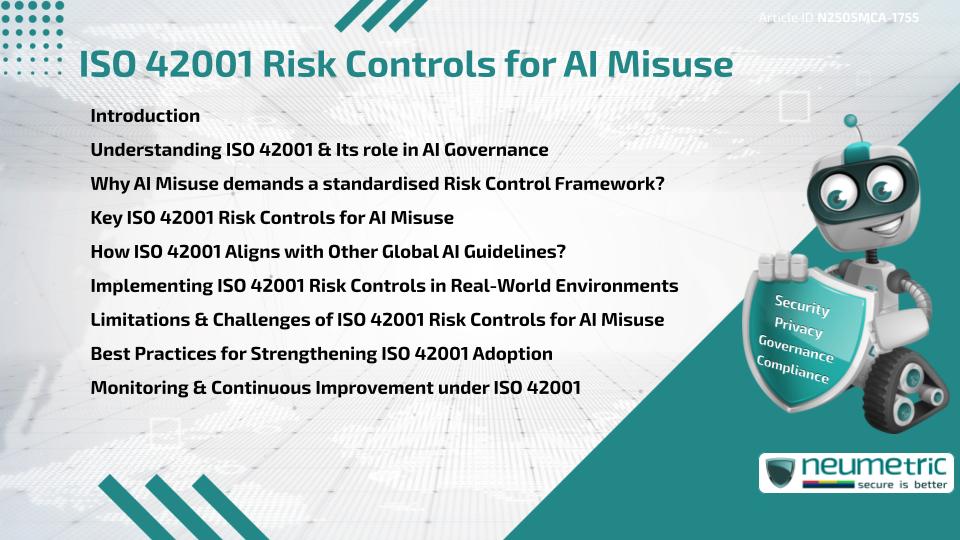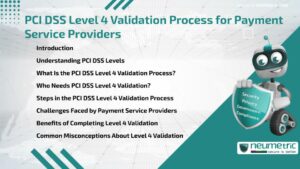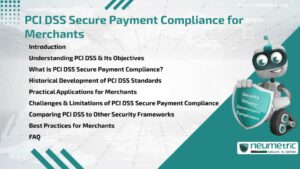Table of Contents
ToggleIntroduction
Artificial Intelligence [AI] is transforming Industries, enhancing Decision-making & improving User Experiences. However, AI also brings significant Risks especially when misused. Whether intentional or accidental, misuse of AI can lead to Bias, Privacy Violations or even Physical Harm. That is why a structured approach to managing these Risks is essential.
The ISO 42001 Risk Controls for AI misuse offer a globally accepted Standard to help Organisations identify, mitigate & monitor AI-related Risks. This article explores what ISO 42001 includes, how it helps prevent misuse & what Organisations can do to implement it effectively.
Understanding ISO 42001 & Its role in AI Governance
The first International Standard designed specifically for Artificial Intelligence Management Systems [AIMS] is ISO 42001. It provides a Framework to help Organisations Develop, Deploy & Manage AI Systems responsibly.
While similar in structure to ISO 27001 for Information Security & ISO 9001 for Quality Management, ISO 42001 is tailored to the unique challenges AI presents. It includes a lifecycle-based approach, covering Planning, Design, Development, Deployment & Monitoring of AI Systems.
Key features include:
- Emphasis on Transparency & Accountability
- Stakeholder engagement across AI Decision-making
- Systematic identification of misuse scenarios
Why AI Misuse demands a standardised Risk Control Framework?
AI misuse can occur in multiple forms:
- Use of Biased Datasets that lead to Discriminatory Outcomes
- Overreliance on Automated decisions without Human oversight
- Malicious manipulation of AI Systems, such as Deepfakes or Fraud
Without effective Controls, these issues can lead to Legal Penalties, Reputational damage or Harm to Individuals & Communities.
The ISO 42001 Risk Controls for AI misuse establish a structured way to:
- Assess potential Misuse Risks across all phases of the AI Lifecycle
- Apply proportionate Safeguards based on context & criticality
- Maintain an Auditable & Explainable process
Key ISO 42001 Risk Controls for AI Misuse
ISO 42001 outlines a series of Risk Controls that Organisations must consider. These are not one-size-fits-all but rather scalable according to Risk appetite & system impact.
Some of the key Controls include:
- Purpose Alignment: Ensuring AI is only used for its intended, lawful purpose.
- Role-Based Access Controls [RBAC]: Limiting who can access & modify AI Systems.
- Data Governance Policies: Managing Data Quality, Lineage & Consent.
- Bias Monitoring & Correction: Regularly evaluating output for unfair patterns.
- Human Oversight Mechanisms: Enabling Human review or intervention when needed.
- Auditability & Traceability: Keeping Logs & Documentation for decision review.
How ISO 42001 Aligns with Other Global AI Guidelines?
The principles of ISO 42001 align closely with other Regulatory & Ethical Frameworks including:
- The EU AI Act, which classifies AI Risks into categories & mandates Control Measures
- The OECD AI Principles, which emphasise Inclusive Development and Human-centric Values.
- UNESCO’s Recommendation on the Ethics of AI, with a focus on its broader Societal implications.
ISO 42001 provides a practical implementation Framework that supports Compliance with these broader initiatives.
Implementing ISO 42001 Risk Controls in Real-World Environments
Adopting ISO 42001 Risk Controls for AI misuse requires a strategic & phased approach:
- Gap Assessment: Conduct a Gap Analysis to compare existing Policies against ISO 42001 requirements.
- Stakeholder Mapping: Clarify Roles, Responsibilities & Internal AI Expertise
- Control Integration: Embed Controls into existing processes (Such as: DevOps, CI/CD)
- Documentation & Training: Ensure staff understand Policies & Procedures
- Third Party Risk Management: Extend Compliance to Vendors or Partners
Limitations & Challenges of ISO 42001 Risk Controls for AI Misuse
Despite its strengths, ISO 42001 is not without limitations:
- Flexibility vs Specificity: The Standard is broad & may need tailoring to specific Use Cases
- Complexity: Implementing all Controls can be resource-intensive, especially for Small Organisations
- Subjectivity in Risk Assessment: Different teams may assess AI misuse Risks differently
Still, these challenges can be mitigated with proper training, Third Party Audits & Ongoing Reviews.
Best Practices for Strengthening ISO 42001 Adoption
To ensure that ISO 42001 Risk Controls for AI misuse are effective, Organisations should:
- Conduct periodic Risk Assessments using defined Templates
- Establish cross-functional AI ethics committees
- Adopt open-source Toolkits for Bias Detection & Model explainability
- Use scenario planning to Test systems under abnormal or malicious conditions
Monitoring & Continuous Improvement under ISO 42001
ISO 42001 promotes an iterative cycle of improvement. Controls must be regularly reviewed, refined & updated based on:
- System performance & User feedback
- Changes in Laws, Policies or Technologies
- Incident Reports or Misuse Events
This aligns with the “Plan-Do-Check-Act” model, helping Organisations build Resilience & Trust over time.
Balancing Innovation & Responsibility with ISO 42001
The ultimate goal of the ISO 42001 Risk Controls for AI misuse is not to restrict innovation, but to guide it responsibly. By embedding safeguards from the start, Organisations can:
- Launch AI Products faster with lower regulatory friction
- Build public Trust through Transparent practices
- Avoid costly failures due to unintended misuse
Takeaways
- ISO 42001 is the first Global Standard for managing AI Systems responsibly
- Its Risk Controls help prevent misuse scenarios such as Bias, Over-automation or Data abuse
- Implementation requires Cross-functional effort & Lifecycle-wide integration
- Despite some limitations, it supports alignment with global Ethical & Legal Frameworks
- Continuous Improvement & Monitoring are core to its success
FAQ
What is the purpose of ISO 42001 Risk Controls for AI misuse?
These Controls aim to prevent harmful outcomes by managing AI Risks across its entire Lifecycle through Policy, Design & Oversight Mechanisms.
How are ISO 42001 Risk Controls for AI misuse different from general IT Controls?
They focus specifically on the Ethical, Societal & Operational Risks associated with AI Systems rather than general Software or Infrastructure issues.
Can ISO 42001 Risk Controls for AI misuse help meet Legal Obligations?
Yes, they align with Laws like the EU AI Act & Principles from NIST or OECD, supporting both Compliance & Ethical AI Governance.
Do Small Businesses need to implement all ISO 42001 Risk Controls for AI misuse?
No, the Framework is scalable. Smaller Organisations can implement only the Controls relevant to their Use cases & Risk levels.
Are ISO 42001 Risk Controls for AI misuse only applicable to High-Risk Systems?
While they are most critical for High-Risk AI, even Low-impact Systems benefit from Transparency & Ethical Safeguards.
How often should ISO 42001 Risk Controls for AI misuse be reviewed?
Ideally, every six (6) to twelve (12) months or whenever there is a significant change in System Functionality or External Regulations.
Is Certification necessary to use ISO 42001 Risk Controls for AI misuse?
Certification is not mandatory, but it adds credibility & helps demonstrate accountability to Clients & Regulators.
What Tools support ISO 42001 Risk Controls for AI misuse?
Bias Detection Frameworks, Model Explainability Platforms & AI Risk Dashboards are commonly used to support implementation.
Need help?
Neumetric provides Organisations the necessary help to achieve their Cybersecurity, Compliance, Governance, Privacy, Certifications & Pentesting goals.
Organisations & Businesses, specifically those which provide SaaS & AI Solutions, usually need a Cybersecurity Partner for meeting & maintaining the ongoing Security & Privacy needs & requirements of their Clients & Customers.
SOC 2, ISO 27001, ISO 42001, NIST, HIPAA, HECVAT, EU GDPR are some of the Frameworks that are served by Fusion – a centralised, automated, AI-enabled SaaS Solution created & managed by Neumetric.
Reach out to us!





